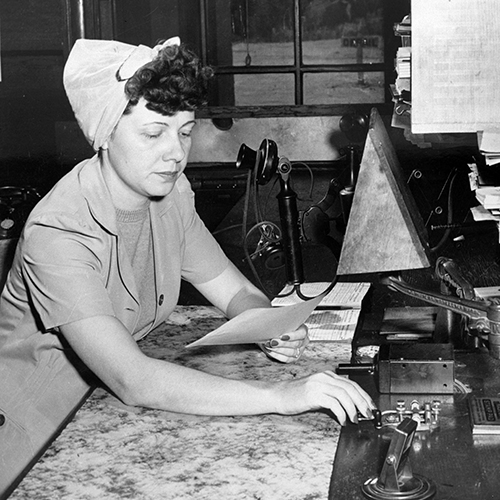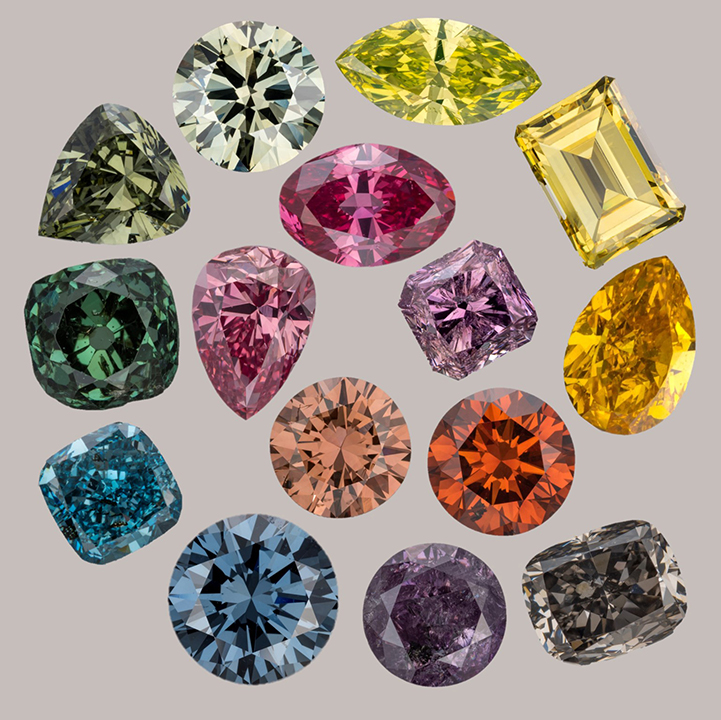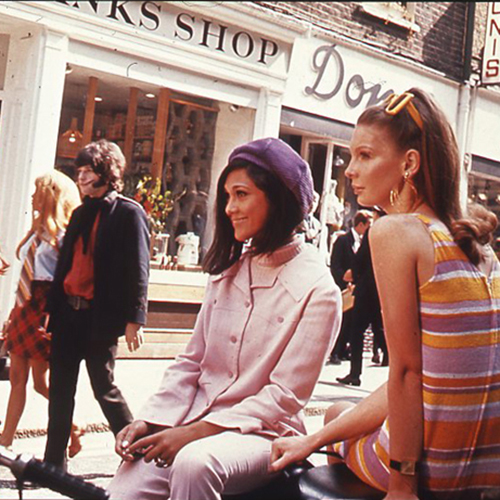We're marching into spring next week, and this month's edition offers an array of ways to add even more color to the season. From a rare red diamond to the vibrant palettes of artists across the centuries, the dazzle of a long-hidden trove of luxury items that adorned A-list Londoners during the Renaissance to the pop of Carnaby Street fashions in the 1960s, there's a rainbow of programs ready for you to enjoy. You'll also find intriguing offerings focused on Women's History Month.
And, as always, this lively monthly collection is designed to make sure you continue to enjoy what you've come to value from Smithsonian Associates: programs and experiences that are entertaining, informative, eclectic, and insightful.
Trailblazers and Visionaries
 Vera Lichty, a wartime telegraph operator, Union Pacific telegraph office, 1944 (Union Pacific Collection/The Union Pacific Railroad Museum)
Vera Lichty, a wartime telegraph operator, Union Pacific telegraph office, 1944 (Union Pacific Collection/The Union Pacific Railroad Museum)
As we celebrate Women's History Month, Smithsonian Associates' programs have many stories to tell. They explore power in a 12th-century queen consort, Eleanor of Aquitaine, who sat on the thrones of both France and England (Wednesday, March 26) and reigning queens of the screen, Joan Crawford and Bette Davis, whose kingdom was golden-age Hollywood (Tuesday, May 13 and May 20). Discover the roles that a group of remarkable 19th-century New England women played in shaping Transcendentalism (Thursday, March 20) and the groundbreaking telegraphers who supported the railroads as their tracks spread across the West (Wednesday, April 9).
Follow a group of 1950s Abstract Expressionists whose tenacity-and talent-brought their works to gallery walls (Tuesday, March 25) and the women architects who, despite roadblocks, made their marks on Modernism (Wednesday, May 21). Hear from several leading Washington-area chefs about how they've found success in a male-dominated profession and sample a bite from each of their menus (Thursday, March 27). And spend a day immersed in the world of a 19th-century author whose novels continue to capture our imagination (Saturday, April 5): Happy 250th birthday, Jane Austen!
Collections That Sparkle
 Selections from the Winston Fancy Color Diamond Collection (Photo by Robert Weldon, arranged by Gabriela Farfan, courtesy of Ronald Winston))
Selections from the Winston Fancy Color Diamond Collection (Photo by Robert Weldon, arranged by Gabriela Farfan, courtesy of Ronald Winston))
The Smithsonian's National Museum of Natural History unveils the Winston Red Diamond and Winston Fancy Color Diamond Collection on Tuesday, April 1-an extraordinary showcase of some of the world's rarest and most dazzling gems. The breathtaking diamonds were gifted to the museum by Ronald Winston, the son of distinguished jeweler and gem collector Harry Winston. In 1958, Harry Winston donated the iconic Hope Diamond to the Smithsonian, laying the foundation for the National Gem Collection. Now, the Winston Red Diamond and Winston Fancy Color Diamond Collection will be featured in the museum's Winston Gallery, offering visitors the rare opportunity to witness one of the finest collections of fancy color diamonds ever amassed.
Natural red diamonds are among the rarest gemstones on Earth, and the Winston Red Diamond stands out as one of the most exquisite in existence. At 2.33 carats, it ranks among the largest diamonds ever bestowed with the coveted "Fancy red" color grade by the Gemological Institute of America. The diamond features an old mine brilliant cut, a style that predates the round brilliant cut used in engagement rings today. With fewer, larger facets, this distinctive cut suggests the stone was fashioned before the mid-1900s. The Winston Red Diamond will be displayed alongside 40 other gems from the Winston Fancy Color Diamond Collection. The stones will be arranged in a radiant rainbow of color, featuring every shade imaginable from deep teal to soft peach.
Hidden gems and hidden stories take the spotlight in an upcoming Smithsonian Associates program on Wednesday, August 6. For nearly 400 years, a treasure lay buried under the busy streets of London. Unearthed by accident in 1912, a dazzling collection of jewels, necklaces, pins, rings, chains, scent bottles, and other precious objects was revealed in the cellars of a demolished building. Probably buried at the time of the Great Fire of London or English Civil Wars in the mid-17th century, the abandoned stash was most likely the stock of a goldsmith jeweler in Cheapside. Tudor scholar and historian Carol Ann Lloyd-Stanger examines the fascinating story of this collection of luxury items-now known as the Cheapside Hoard¬-and what they reveal about how royals and nobility in the 16th and 17th centuries used such pieces to communicate power. Registration for this program opens on May 1. Sign up for world history e-Alerts to be among the very first to know about new offerings like this.
Looking Back
 Carnaby Street, 1960s London (The National Archives /United Kingdom/CC BY 4.0)
Carnaby Street, 1960s London (The National Archives /United Kingdom/CC BY 4.0)
Everyone feels nostalgic about something-it could be a fondly remembered movie, a teenage romance, or maybe a comfort food. There are reasons behind that feeling. On Thursday, March 13, Jeffrey Green, a professor of psychology at Virginia Commonwealth University, dives into the psychology of nostalgia and similar forms of mental time travel. Green tackles questions such as what nostalgia actually is and whether it's a healthy emotion. Examining triggers-how foods, scents, and songs can transport us back to cherished memories-Green also explores the connections between the senses and the emotional landscapes they evoke.
Historians are experts at looking back, and Julie Taddeo is among them. On Tuesday, March 18, she focuses on the swinging city of London in the '60s and the cultural revolution that happened there. Carnaby Street set the styles; Mod designers such as Mary Quant shone; Twiggy, a model from a working class-family, was the face of the moment; and Soho's nightclubs were the place to dance the night away. Taddeo explores how London¬-and all of Britain¬-transformed from staidness to a with-it world powerhouse that exported its pop culture amid the Cold War, a new Elizabethan age, and the country's decline as an imperial power. In addition, she talks about how a new generation rejected the values, fashions, and especially the class system of the past.
Time-Traveling Through Art
 Group of Courtesans, Company style, 19th century, northern India
Group of Courtesans, Company style, 19th century, northern India
One of the distinctive elements of Smithsonian Associates' World Art History Certificate program is its breadth of scope, offering compelling topics that span centuries of creators and forms. A trio of upcoming programs offers some intriguing time-travelling experiences for art aficionados-and each carries certificate credit.
Leonardo da Vinci is perhaps the most diversely talented individual ever to have lived. Even calling him the prime example of the Renaissance man falls short for an expert in invention, sculpture, architecture, painting, science, music, engineering, anatomy, and astronomy. Against the backdrop of Renaissance Italy, art historian Aneta Georgievska-Shine highlights some of the most remarkable aspects of Leonardo's life, work, and creativity in a full-day exploration on Friday, March 28.
During India's colonial period from the mid-18th to mid-20th centuries, the British imperial system sought out Indian resources for exploitation and had a dramatic impact on the traditional arts and crafts of the subcontinent. In a 4-session series from Tuesday, March 25 to April 15, art historian Robert DeCaroli traces the rising influence of European powers in South Asia. Topics include the late art of the Mughal Empire, Company painting, Orientalism, photography, traditional crafts for domestic and foreign markets, Indo-Saracenic architecture, and colonial museums.
Pablo Picasso reinvented himself every few years with groundbreaking creative developments that would change the course of art. Art historian Joseph P. Cassar looks at Picasso's early years, his Blue and Rose periods, his masterpiece Guernica, and his lifetime of artistic experimentation and innovation marked by playfulness and genius. The 4-session series runs from Wednesday, April 9 to 30.
Learn More About the Certificate Program
View Past Issues
Select a past issue to view: